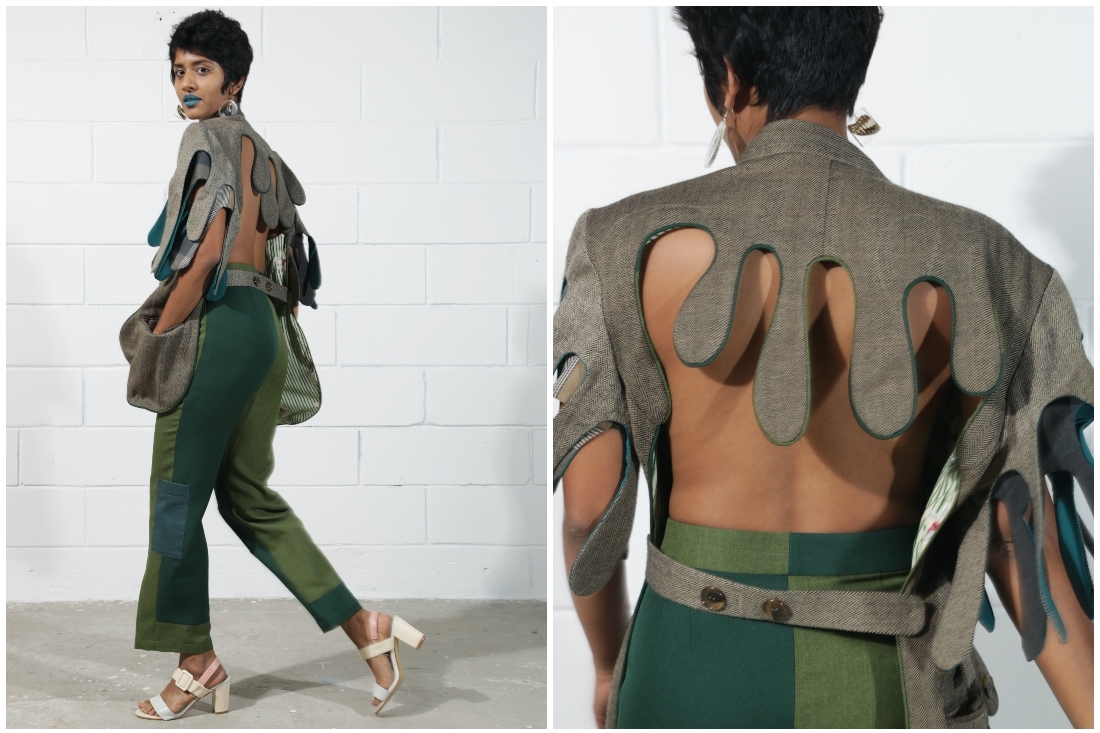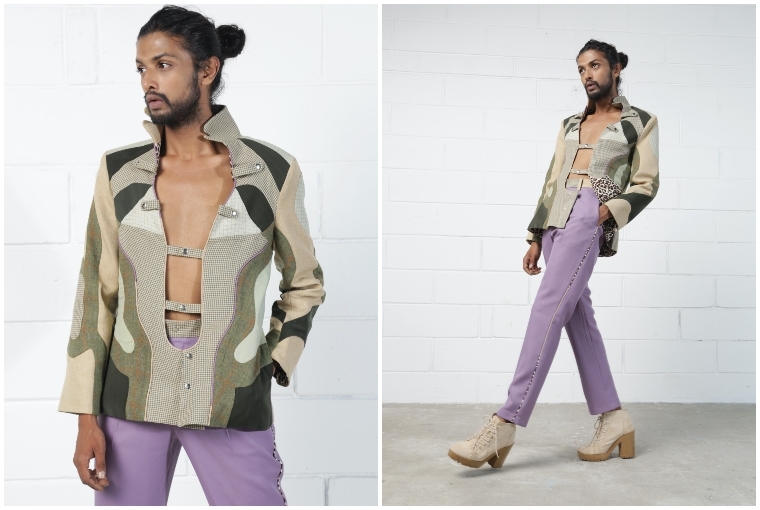
The Drip blazer has been constructed using a Vintage Ralph lauren blazer and is reversible, the dual tone pants are made using 2 trousers

The Drip blazer has been constructed using a Vintage Ralph lauren blazer and is reversible, the dual tone pants are made using 2 trousers
Conceived during a conversation between friends immensely passionate about the fashion industry and its future, Grandma Would Approve began with a succinct thought process. Priyanka Muniyappa, a designer and Anugrah Samuel Phillips, a stylist, wanted individuals to be aware of the crisis posed by clothes. The fast-fashion model may boast of being able to provide trends straight off the runway, but the amount of waste it creates is alarming. With labels coming up with new styles every week, the cycle of our clothing has become much shorter. We constantly want new clothes hence we mindlessly discard the older ones, generating more and more waste. This constant consumption paired with ignorance, poses a grave threat to the environment and our future. A study conducted by ASSOCHAM and PwC suggests that India would require landfills the size of New Delhi by the year 2050 with the amount of waste being produced. Hence the need for Grandma Would Approve, a label with conscious zero waste practices that believes in up-cycling, restoring and reconstructing vintage couture handpicked from fashion haunts across the world.
Grandma Would Approve isn't a run-of-the-mill label. They work with six categories and source clothes from all over the world. Some of their novel categories include Stitched wherein they particularly experiment with unusual fabrics. With Vintage Restore they reconstruct and replace all damaged parts, thus modernising vintage clothes. Reconstructed Couture on the other hand is a unique category that best celebrates their creativity and experimentation. It involves a complete deconstruction of five to ten vintage couture pieces, which are then put together as one — varied kinds of style amalgamated in one piece.
Breaking down their sourcing process, Priyanka explains, ‘Anugrah and I have extensively travelled around India and some places abroad, so we always like to explore a place through its food and fashion. We began sourcing garments from the U.S., U.K., Korea, Bali, Vietnam and Japan through travel and also through friends who reside there. Whenever my sister would make her way back from New York I would get her to source garments for us, the same goes for other friends travelling for longer periods. Anugrah has family in London so we have our steady flow of garments from there as well. We have done our homework about the styles of clothing through the ages, so by looking at the construction and features of the garment, we are able to tell which era it mostly belonged to. Categorising the garments is the fun part of sourcing.’
Co-founder Priyanka hails from a family of artistic individuals. Her childhood involved cutting up and playing around with her siblings’ hand-me-downs. Experimentation and designing comes naturally to her. Every year, since the past eight years on her birthdays, she gifts herself offbeat outfits created from her mother’s old sarees. She elucidates, ‘it's something I took on as a hobby for my own wardrobe because I had ideas in my mind, but couldn't always afford or find the garment available in the market, so I would get them made for myself instead. My parents recognised that I was drawn towards design, so NIFT was the best option to develop those skills further and channel my energy in the right direction.’
Anugrah on the other hand started out with a degree in Media Studies and Psychology, but soon found himself immersed in the world of fashion. It came to him naturally and his family also helped foster the creativity required for design. Hailing from Jhansi, he would always accompany his father to the local tailor. He would aid with fabric selection and brain stormed about the kind of fit and style required. He adds, ‘The same went with shoes, I would find out who was the best shoe-smith in Jhansi and go over to him, sit with him for hours on end and ask him to design boots and platform shoes. My aunts and grandmother always kept aside their favourite vintage clothing for me. The texture of the fabric, the beautiful construction, the buttons, the fit would leave me awestruck and I have a beautiful collection of hand-me-downs that have been passed down within my family for generations.’
Their like mindedness and similar childhood experiences culminated through Grandma Would Approve. Talking specifically about the gap in the current landscape of fashion their label attempts to fulfill, they both add, ‘Change in ideology is of utmost importance. Through Grandma Would Approve, we hope to remind people of an empathetic and slow process of production that has no guilt or destruction attached to it. We honestly don't need any new fabrics being created, we have a lot of waste generated by the human race and it is time to take ownership of that waste. It is time to circulate, up-cycle, reuse and recycle.' By preventing garments from crowding landfills even more, they wish to prevent further emission of greenhouse gases that cause a spike in temperatures and release toxins, thus speeding the climate crisis. Their aim is to treat the environment like a complex living organism that doesn't just exist to cater to human greed, but rather as our hearth. The way forward for them is to bring about some real change, by altering old methods of production, which never considered their own environmental impact.

The pastel blazer set has been constructed using 2 vintage blazers, 1 trench, 2 woolen shirts, 1 dress and 3 trousers.
Their philosophy invokes the image of our grandmothers, who they believe to be the pioneers of sustainability — the original sources of making things new, picking up scraps of fabrics and putting things together. The figures of perennial wisdom, always quick in their thinking and capable of coming up with kinder solutions conscious of everyone involved. The question the duo wish to ask us — Would grandma really approve of our contemporary buying habits? No, she wouldn't. Fashion as we know it is in the process of completely revamping itself. It’s the need of the hour and Priyanka and Anugrah believe the future should be one that is compassionate towards nature.
Throughout the lockdown team Grandma Would Approve has been fairly relaxed — they realised spending money on clothes wasn’t the primary instinct, rather being safe was. They both spent time working on their personal goals and craft. For the label, they wish to work on getting themselves out there more. In the times of Covid19, when the new normal presents a future laden with uncertainty, Priyanka and Anugrah are going with the flow, polishing their creativity and are excited to introduce distinctive garments that celebrate individuality.
Text Unnati Saini